Two years ago, when the Taliban seized power in Afghanistan, the U.S. Embassy in Kabul closed and the U.S. military evacuated more than 100,000 Afghans in a chaotic withdrawal from Afghanistan.
A significant number of evacuees who worked for the U.S. government during the war are still going through immigration proceedings to allow them to permanently live in the United States.
For those still waiting in third countries, if they have an immediate family member who has legal U.S. status, that person can petition to have their relative resettle in the U.S.
Others can take advantage of pathways within the U.S. Refugee Admissions Program that allow people to join their immediate relatives in the U.S.
P1, P2, P3
In early August 2022, the State Department announced new priority eligibility under the U.S. Refugee Resettlement Program for Afghans who worked for the U.S. government (P1), or worked for U.S.-based nongovernmental organizations or American news organizations (P2), or have immediate family members in the U.S. who are refugees or asylees (P3).
But even if an Afghan evacuee qualifies for these programs, there is no guarantee they will be approved for resettlement to the United States.
"All applicants must pass extensive security checks and complete an interview with a Department of Homeland Security/US Citizenship and Immigration Services officer," the State Department website says.
U.S. Refugee Admission Program
The USRAP provides a straightforward path to the refugee resettlement process, but first refugees must, on their own, reach a third country where they can contact the State Department to begin the resettlement process.
Applicants are prescreened at one of a handful of Resettlement Support Centers scattered around the world. This is followed by an interview conducted by a U.S. immigration officer, multiple security checks, and a medical examination to determine their eligibility for resettlement in the United States.
The State Department is managing referrals to the refugee program, but there is no direct contact between an applicant and the U.S. government before an applicant leaves Afghanistan.
It can take the department 12-18 months to process an application, the department's website says, so applicants would need to live in a third country and support themselves and their families until the case processing is complete.
The third priority category offers access to the refugee program for those whose immediate family members have entered the United States as refugees or were given asylum within the past five years.
Family-based paths
A person with refugee or asylee status in the U.S. can seek "follow-to-join benefits" for their spouse or unmarried children younger than 21, who were not previously given refugee status.
Those who have humanitarian parole status, or were initially paroled into the United States and later received Temporary Protected Status, can also file for their spouse and unmarried children under 21 for entry to the United States as refugees.
Or U.S. citizens and lawful permanent residents can file a petition for certain relatives to immigrate to the United States.
Through the Immigration and Nationality Act of 1965, Congress established the family immigration procedures we know today.
The law creates a preference system allowing U.S. citizens or lawful permanent residents to sponsor immediate relatives, including spouses, unmarried minor children and parents, to immigrate immediately to the U.S. without any numerical limits.
The U.S. citizen or resident files an application that includes a 12-step process within the U.S. Citizenship and Immigration Services and State Department.
Once approved, applicants will receive travel documents to resettle in the United States.
The Department of State funds the international transportation of refugees resettled in the United States through a program administered by the International Organization for Migration.
Refugees are expected to pay back their travel expenses, starting six months after they arrive.
They are also assigned to a sponsoring resettlement agency that provides assistance with services such as housing and employment upon the refugee's arrival in the U.S.
Under U.S. immigration law, those under refugee status may apply for green cards to become permanent residents after one year in the United States. After five years of permanent residency, they can apply for U.S. citizenship.







